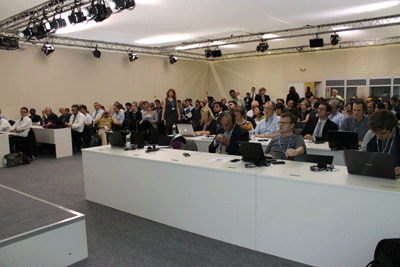 Yesterday saw the main UNFCCC Side-event on CCS, organised by IEAGHG, University of Texas, CCSA and CO2GeoNet. The event was titled “Carbon Capture and Storage (CCS): Achievements and Opportunities for Developing Country Involvement”. The event was very well attended, with around 200 attendees, many from developing countries, and various media.
Yesterday saw the main UNFCCC Side-event on CCS, organised by IEAGHG, University of Texas, CCSA and CO2GeoNet. The event was titled “Carbon Capture and Storage (CCS): Achievements and Opportunities for Developing Country Involvement”. The event was very well attended, with around 200 attendees, many from developing countries, and various media.
 After scene-setting by myself, Philip Ringrose of Statoil presented on 19 years of operations in the North Sea region, which appeared to be impressive news to some that CCS had been in operation so long. Ton Wildenborg of CO2GeoNet presented on EU pilot projects which have collectively demonstrated the safety of storage. We were privileged to have The Honourable Brad Wall, Premier of Saskatchewan, Canada, provide a politicians perspective and to introduce Mike Marsh President of Saskpower to talk about the first year of operation at Boundary Dam. This included their global knowledge centre which is going to be launched and will be supported by BHP Billiton. This will be a new international research centre based around SaskPower’s facilities and experiences with capture at Boundary Dam and storage at Aquistore, and which will be open to international participation. Katherine Romanak of University of Texas BEG presented on new collaboration opportunities in offshore storage, referring to the Carbon Sequestration Leadership Forum’s recent report, and sa planned international workshop to share knowledge between “those who do and those who are interested in doing”. The event concluded with a talk on the Climate Technology Centre and Network, a funding source for technology transfer and capacity building in developing countries, by its Director Jukka Uosukainen.
After scene-setting by myself, Philip Ringrose of Statoil presented on 19 years of operations in the North Sea region, which appeared to be impressive news to some that CCS had been in operation so long. Ton Wildenborg of CO2GeoNet presented on EU pilot projects which have collectively demonstrated the safety of storage. We were privileged to have The Honourable Brad Wall, Premier of Saskatchewan, Canada, provide a politicians perspective and to introduce Mike Marsh President of Saskpower to talk about the first year of operation at Boundary Dam. This included their global knowledge centre which is going to be launched and will be supported by BHP Billiton. This will be a new international research centre based around SaskPower’s facilities and experiences with capture at Boundary Dam and storage at Aquistore, and which will be open to international participation. Katherine Romanak of University of Texas BEG presented on new collaboration opportunities in offshore storage, referring to the Carbon Sequestration Leadership Forum’s recent report, and sa planned international workshop to share knowledge between “those who do and those who are interested in doing”. The event concluded with a talk on the Climate Technology Centre and Network, a funding source for technology transfer and capacity building in developing countries, by its Director Jukka Uosukainen.
The excellent quantity and quality of questions that followed demonstrated the hjosir level of interest and positive engagement in the event and the topics, such that discussions had to continue after the event outside the room, with panel members also being interviewed by various media. Not surprisingly, questions was asked and concerns were expressed around the UK government’s recent policy change on the CCS Competition.
 Overall, I think that the Side-event achieved its objectives of communicating the messages that CCS projects have successfully operated for many years, from small pilot-scale projects to large-scale such as at Boundary Dam, and new opportunities are becoming available to share this knowledge and these experiences, such as through SaskPower’s new global knowledge centre and in offshore storage.
Overall, I think that the Side-event achieved its objectives of communicating the messages that CCS projects have successfully operated for many years, from small pilot-scale projects to large-scale such as at Boundary Dam, and new opportunities are becoming available to share this knowledge and these experiences, such as through SaskPower’s new global knowledge centre and in offshore storage.
Reporting of the event at COP by IISD can be seen at http://www.iisd.ca/climate/cop21/enbots/1dec.html#event-6 , and the ppts are available on the UNFCCC Side-event website at https://seors.unfccc.int/seors/reports/events_list.html?session_id=COP21 (see Tuesday 1 December 15:00).
 In addition, the exhibit booth on CCS, run jointly by University of Texas, CO2GeoNet, CCSA and IEAGHG, was proving very busy, with a continuous flow of COP delegates seeking a range of information on CCS. IEAGHG are using it in particular to promote the International Journal of Greenhouse Gas Control Special Issue and the new report on Boundary Dam.
In addition, the exhibit booth on CCS, run jointly by University of Texas, CO2GeoNet, CCSA and IEAGHG, was proving very busy, with a continuous flow of COP delegates seeking a range of information on CCS. IEAGHG are using it in particular to promote the International Journal of Greenhouse Gas Control Special Issue and the new report on Boundary Dam.
Elsewhere in the COP, the main negotiations started yesterday. Good luck to all involved.
(photos' courtesy of UKCCSRC)


